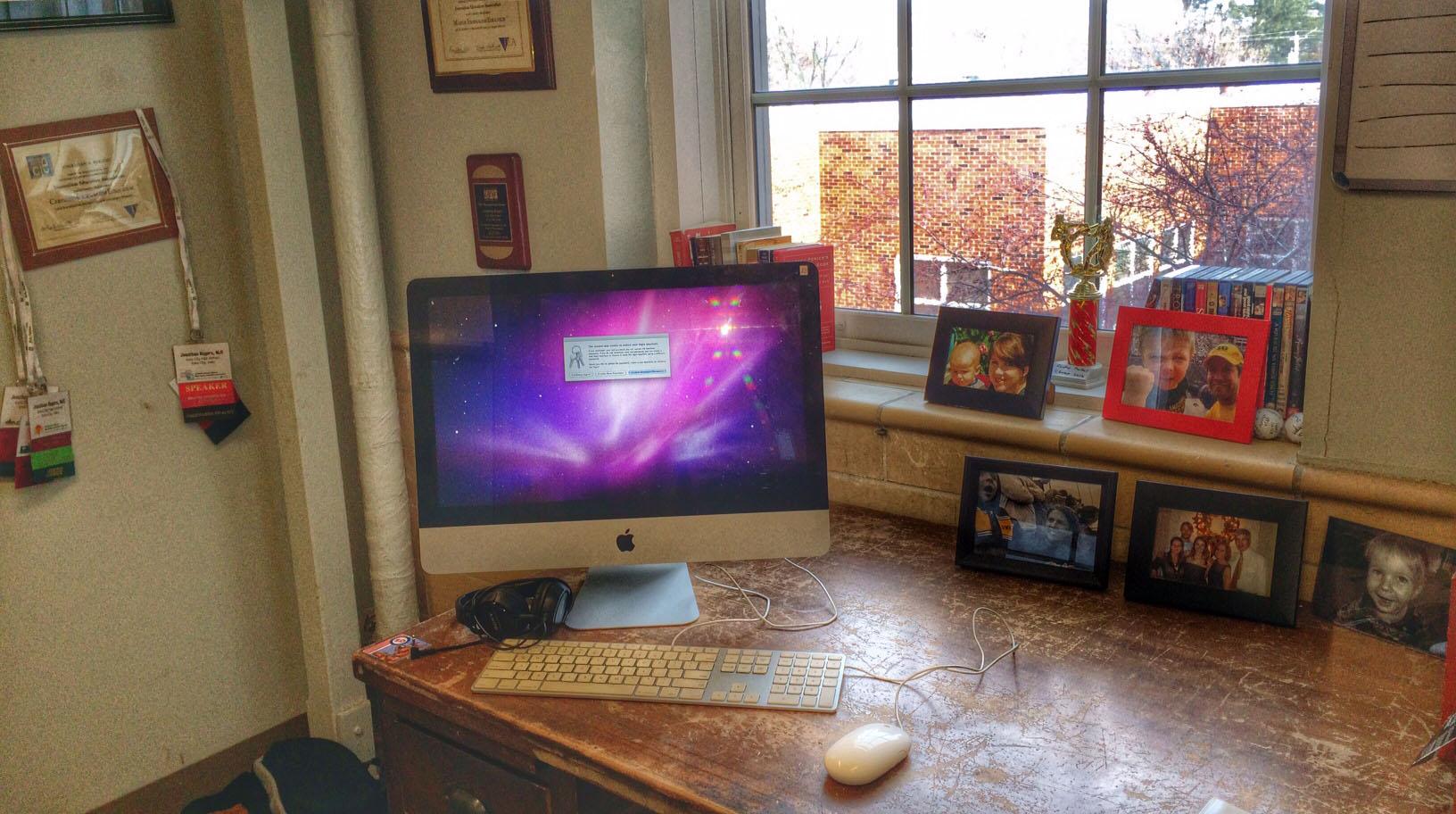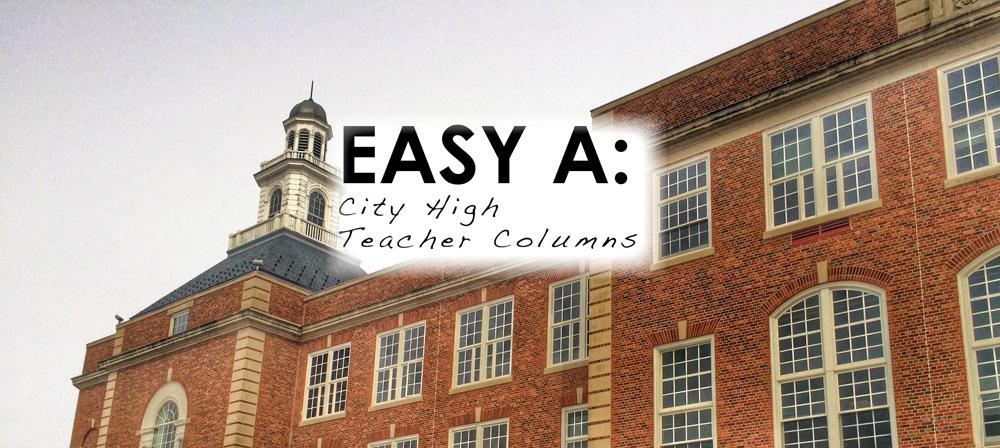Your donation will support the student journalists of Iowa City High School. For 2023, we are trying to update our video and photo studio, purchase new cameras and attend journalism conferences.
Easy A: City High Teacher Columns
Below are teacher columns on life, surviving high school, being a great student and succeeding at The School that Leads.
February 24, 2013

Mr. Rogers’ Desk in room 2109
Mr. Rogers’ Twitter Tips
Below are a few tips and resources for teenagers using Twitter or having social media problems.
Recently, students asked me to write out a few Twitter tips after we discussed the vulgar attacks on Zach McCabe and his vulgar response on Twitter this past weekend. Attacks and responses, which ended in Fran McCaffery suspending all his players from using their Twitter accounts.

In class, I work to teach journalism students how to use Twitter as an educational tool and to use social media responsibly. Twitter has recently released their own tips you can read here. I also recommend Emily Bazelon’s book Sticks and Stones, as I agree with her that the worst thing we can do is to let teens venture into the world of social media without any guidance.
#1: Do No Harm
Remember that Twitter is a publishing tool and one of the key rules of publishing is to DO NO HARM. When you tweet, you are publishing to the world. The illusion of a private account on Twitter or Facebook is an illusion, sorry for being redundant. If you post something on Twitter or Facebook expect that everyone at City High, Iowa City, and the world will see it. Also, expect that future college admissions officers, job recruiters, parents, and significant others might see it as well. This should scare you a bit. When or if it has gone too far on Twitter seek help from a teacher, parent, guidance counselor, or Mr. Bacon. The following online resources have been developed to help teens in trouble as well.
Teen Line | @teenlineonline
Stop Bullying | @stopbullyinggov
A Thin Line | @a_thin_line
That Girl in Pink | @benni_cinkle
#2: Twitter is Grrrreat!
After point number one you may be doubting point number two, but I really do love Twitter. According to the Center for Learning and other sources Twitter ranks as the #1 educational tool and used in the right way it is everything the internet can be. It can be an amazing resource, a way to communicate with famous writers, and most importantly have a much better information feed than Facebook. The full power of Twitter is also only used in combination with Hootsuite, Instagram, and Flipagram. (See step three on how to make great Twitter feeds)
#3 Make Twitter Lists
See this Mashable tutorial on the technical aspects, but a Twitter list is a great way to organize people or organizations you follow on Twitter. Here are all the Twitter lists I have created. They include lists of my favorite writers, great news feeds, and hundreds of high school publications, which leads me to tip number four.
#4 Use Twitter Professionally and to Learn
Millions of adults use Twitter to connect professionally and share resources. A recent Rutgers University study also found that over 50% of college students wished they gained more professional knowledge and experience. One of the best places to gain professional knowledge and connections on the internet is through Twitter. If you’re interested in law, a student should have a Twitter list of law publications and lawyers. If a student is interested in medicine they should have a Twitter list of medical publications and famous doctors on Twitter. Many college professors in academic fields are also publishing on Twitter. Creating a Twitter list for a field of study is also a great idea. Twitter is not just for journalists to follow other journalists. Although, following great writers and journalists is a great list as well.
#5 Take a stand against bullying and abusive Tweeting!
If you see bullying going on online report it to a teacher, parent, guidance counselor or principal. Laughing or remaining silent allows abusive behaviors and words to continue.

Ms. Fettweis teaching an honors English course.
Plagiarism Goes to the Heart of Integrity
Last fall, when Senator Rand Paul (R-KY) faced repeated charges of plagiarism, he suggested that he’d like to end the discussion by challenging his critics to a duel. Rand eventually backed down and acknowledged he’d relied far too heavily on unacknowledged sources’ language. But I still couldn’t get past his seemingly harsh reaction–a duel? Seriously? This kind of defensiveness reminds us what a serious issue plagiarism is. It goes directly to the heart of a person’s integrity.
Around the same time Sen. Paul was wishing he could settle his problems with pistols, City High purchased a subscription to Turnitin.com, a website that helps teachers and students detect plagiarism. When I told one of my classes about this resource, they reacted as if I had challenged them to a duel: they were defensive, scared, even angry about the implicit implications of this program.
Sure, we want to bust blatant plagiarists. But what I tried to assure my students is that this is a tool to help them detect citation errors before a draft is final. After using it this week, they finally believe me. Many were delighted to realize how they effectively synthesized research in their original arguments. If a student relied too heavily on a source, Turnitin showed the student the original source. By seeing sources next to their texts, students got the best possible lesson about how to effectively paraphrase. It’s not a “gotcha” device; it’s a learning tool. I may be naïve, but I believe most students don’t set out to participate in the kind of plagiarism that is most egregious–the kind where a student copies ideas from the internet, pastes them into a Word document, and attempts to pass those stolen words off as the student’s work. That kind of cheating is beyond lazy; it’s foolish. With a five second Google search, the teacher can bust the plagiarist. Duel over. Teacher wins.
The far trickier plagiarism cases, and I hope the far more common ones, happen because students have at their fingertips access to a world of ideas. Often, those ideas have been written by people who are experts in a field. When students see these on-line ideas, they think, “I can’t say that any better.” Inadvertently, students parrot phrases and ideas from internet sources. What students need to know is when and how to give credit to those sources. The conversation about plagiarism, then, needs to move out of the confrontational and into the instructional.
Yet I find myself getting frustrated when I see that students have used on-line summaries or guides to generate their responses to a text. This, too, is plagiarism, after all. I don’t think students do this because they want to cheat or buck the system; they do it because they, like everyone else in the world, don’t like feeling dumb. They just want to know, for example, what the heck a poem is really about. Students think citing that source shows they’ve “cheated.” Often, I have to remind myself of my core belief: my students are honest, decent people who want to do well in school. They see the internet as a tool to help them succeed. And they are right—it is almost unfathomable what the web can do. Is the internet a crutch for the lazy sometimes? Sure. Reading closely and thinking hard presents unavoidable challenges. Using the internet allows people to sidestep those challenges. I just wish City High students realized that what they have to say about issues or texts is far more interesting to most teachers than the “right” answers from the internet.
Plagiarism is an incredibly serious issue. Students who plagiarize in college can get expelled; musicians can get sued; senators can lose their credibility. I’m grateful for City High’s investment in a learning tool that helps students learn to research more effectively. It has helped remind me that we should be discussing how to avoid plagiarism, not dueling over it.
